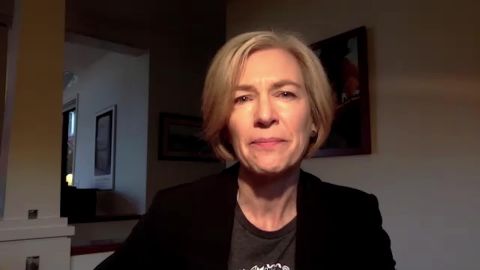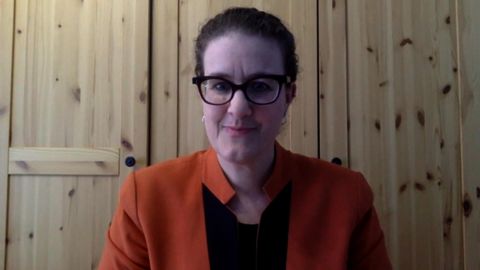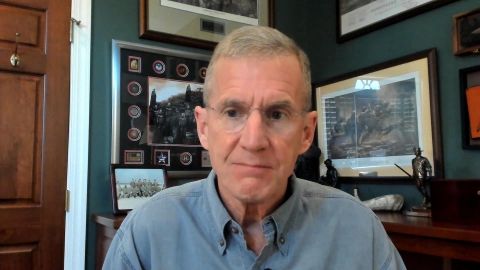Read Transcript EXPAND
CHRISTIANE AMANPOUR: Now, the WHO said that the best way to tackle this virus is to test, test, test. This is a call to action that pioneering biochemist Jennifer Doudna and her colleagues at U.C. Berkeley are working on now, as they aim to use their biology labs to test up to 2,000 samples per day. Doudna, co-founder of the gene editing tool CRISPR, is using that technology to try to fight COVID-19, as she explains to our Walter Isaacson now. And full disclosure, of course, Walter is currently writing a book on Doudna and her work with CRISPR.
(BEGIN VIDEOTAPE)
WALTER ISAACSON: Dr. Jennifer Doudna, welcome to the show.
DR. JENNIFER DOUDNA, UNIVERSITY OF CALIFORNIA, BERKELEY: Thank you for having me.
ISAACSON: In early March, when you watched the spread of the coronavirus, you suddenly decided it was time for scientists to kick into action. So, you took your Berkeley lab and some of the surrounding labs in the San Francisco area, and you mobilized them. Tell me what you did and why.
DOUDNA: We held a meeting to discuss how the scientists at U.C. Berkeley and our surrounding institutions could get together and address this terrible pandemic. And one thing that emerged from that meeting was that we should find a way to use our resources and our knowledge to test for the virus. Many of us agree that one of the most the — most important things to be done right now to address the disease is to understand who’s infected and how to keep others safe.
ISAACSON: And if you decide you’re going to test, you do a regular test, but you have to get it approved, right, by the CDC. And once you have done that, what — can you do, what, 500, 1,000 tests per day?
DOUDNA: So, it’s important to understand we’re academic scientists. We don’t do clinical testing. To do clinical tests with patient samples requires regulatory approval from multiple agencies. So we have been on a very fast track to learn, first of all, what kind of regulation do we need to comply with? How do we ensure compliance? And how do we get our scientists trained to work safely under these conditions, and do it very fast? So we have been fortunate that the state of California under its emergency declaration has made it easier to get approval. The Food and Drug Administration at the federal level has also been very cooperative in helping us to do this. And as a result, we are really getting very close to being able to do a high-throughput tests for patient samples at U.C. Berkeley.
ISAACSON: Many other universities’ labs are being shut down, like with the rest of the university. Do you think it’d be a good idea for universities around the country to get permission to keep their biology labs open and shift them over to this thing of testing, so every community could have a high-throughput testing center?
DOUDNA: Well, I would first say that, you know, we’re inspired by the University of Washington. Many people may be aware that their folks there, scientists, have been testing patient samples for weeks. And they have played a big role, actually, in helping to stem the spread of the SARS-CoV-2 virus up in the Seattle and larger area in Washington state. So we’re inspired by this. I think it’s incredibly important that people be working safely at this time. So we’re very cognizant of having to use low- density laboratory conditions, making sure that our scientists are appropriately protected physically from any potential for infection. But, yes, I mean, I think, beyond that, you know, if those conditions can be met, then I think having scientists working at this time and contributing their expertise to fight this pandemic is very valuable.
ISAACSON: You said SARS-CoV-2. Is that the same as the COVID-19 and the coronavirus we have been talking about?
DOUDNA: Yes. So, let’s do a little terminology check. So I have had to learn this myself. So, SARS-CoV-2 refers to the actual virus that is causing the current pandemic. Coronaviruses are the family of viruses. That’s the family of viruses that SARS-CoV-2 belongs to. And COVID-19 is the terminology for the disease that this virus causes.
ISAACSON: You will be doing the type of tests we have been doing for the past couple of months, which is just a test for the presence of the virus. I have noticed that now, in Britain and other places, they’re starting to do antibody tests. Can you explain the difference?
DOUDNA: Right. So the test that we’re doing at Berkeley is a test that looks at the virus RNA. It’s the genetic material that allows the virus to replicate in — upon infection. So, we’re using a test called the polymerase chain reaction that’s approved by the World Health Organization and the CDC. It’s a standard test. And, importantly, it’s able to detect the presence of the virus very soon after infection. So, the difference between that type of a test and what you’re asking about, what we call a serological tests that looks for antibodies to the virus, is that typically when someone gets exposed to the virus, and their body makes antibodies, it takes a while for that to happen. So, it’s really a test that looks after the fact. Has someone been infected by the virus? Also very useful to know, obviously, and to figure out who has immunity to the virus. But one of the challenges right now with those types of tests, as I have been learning, is that the testing materials are not accurate enough to ensure detection of just the SARS-CoV-2 virus. Right now, there’s a lot of cross-reactivity with other types of viruses. And, of course, many, many virologists and scientists are working on this problem, and they will probably sort it out. But I think that’s one of the challenges with those tests right now.
ISAACSON: It’s taking four to six days to get the results of some of these tests. Would you be able to do it like in a few hours or a day?
DOUDNA: Yes, so that’s a primary goal of our lab at Berkeley and the Innovative Genomics Institute is to be fast. So we have brought in high-throughput robotic equipment. We have got companies helping us with data management, and we hope to be able to do 1,000 to 2,000 samples a day when we get — when we’re rolling.
ISAACSON: As you know, I’m writing a book about you and the discovery of CRISPR, which is a gene-editing technology. And CRISPR, that technology is based on a trick that bacteria figured out over the course of three billion years of how to fight viruses. Can you explain how CRISPR does that for bacteria?
DOUDNA: Sure. So CRISPR is an adaptive immune system. It allows bacteria to detect viruses and protect themselves from future infection. And it’s a system that a handful of scientists were studying. And then, a few years ago, it was recognized that this system, which operates as an immune system, that we could actually harness it as a technology for something quite different, which is genome editing. And I think it’s a — I have been reflecting on this during this pandemic. It’s a fascinating parallel that bacteria have been dealing with viruses forever. They have had to come up with creative ways to fight them. And now here we are, humans, in a pandemic facing this challenge. And so we often think about, how can CRISPR potentially impact this pandemic in ways that will be beneficial to humans?
ISAACSON: Can CRISPR be used as a detection tool to help us detect the virus in ourselves?
DOUDNA: So this is a really interesting use of CRISPR enzymes that takes advantage of something that my lab discovered about how they work, which is that, in some cases, the enzymes are able to interact with a piece of nucleic acid, which is RNA or DNA. And when they do that, they turn on an activity, a capability that allows a big amplification of the signal. So, in other words, for every molecule of virus RNA that gets detected, we can see many, many molecules of a reporter piece of nucleic acid, like a little piece of DNA, getting cut. And so there’s a way to do that, use that activity, such that there’s a big release of a chemical signal that can be seen visually. And so you get up at the — have the ability to use this CRISPR system to literally detect and then report on its detection of a piece of viral RNA very, very quickly.
ISAACSON: So, in other words, you can engineer it so that if it cuts something that’s the virus, we’re talking about, it glows, it sort of has a phosphorescent or some signal. Does that mean you could have home detection kits that could do it quickly? And anybody could just look at it the way, they could a pregnancy test, and say, OK, I have got it.
DOUDNA: That’s the idea, absolutely. I think that’s a very interesting possibility of how this system could ultimately be used.
ISAACSON: Are we talking a week, a month or a year?
DOUDNA: We’re not talking a week. We may be talking months. We’re certainly — I think we’re — I think we’re less than a year from that. It’s hard to say.
ISAACSON: Now, we have been talking about detection, like how can you test them detect this. Let’s talk about treatments for second. I know that, at Stanford, one of your friends and colleagues, Stanley Qi, has come up with something he called PAC-MAN, which is a way for the — actually use a CRISPR-based system to actually attack the virus if somebody’s sick. Tell us how that’s progressing.
DOUDNA: Yes, so this is another clever idea about how to use CRISPR enzymes to fight the viral infection. The idea there is to literally, like — for those of you that remember Pac- Man, like I do, this is literally using enzymes that will go after and cut and destroy only the viral RNA and not RNAs that are present in normal cells. And so this is, I think, a clever approach. It’s been tested in a laboratory setting. And there’s some hope there that — it looks like that, technically, it could work. I think the challenge is, how do you get that into a patient? How you get into infected cells?
ISAACSON: And so, if you wanted to get into infected cells, you would have to have a delivery mechanism. What are the delivery mechanisms?
DOUDNA: Well, it’s very difficult, because in — the infection with this virus involves infection in the lung. And so we would need to have a way to deliver these CRISPR enzymes into lung cells. And that’s something that’s very hard right now. Fortunately, there’s an effort at the Innovative Genomics to do exactly that for a different purpose, namely, for treating cystic fibrosis, which is a lung disease that — where we think eventually the CRISPR technology could have an impact.
ISAACSON: So, the notion that these CRISPR enzymes could cut up and chop away and destroy the COVID-19 virus in somebody’s lungs, let me ask the same question. Is that months away, years away?
DOUDNA: Probably years, honestly. I think we’re trying to accelerate the pace of doing that sort of testing. But, as you may know, that sort of test would require going into human patients and going through phase one, phase two, phase three clinical trials. So this is — realistically, it’s years.
ISAACSON: Another thing CRISPR could do, in theory, would be to edit our own genes, and so that our cells don’t have receptors that allow a particular virus to get in. Is that a possibility?
DOUDNA: Well, that’s a possibility in the longtime future, I would say. It’s certainly not something that will be, I think, effective in this particular pandemic. One of the challenges to doing — taking that approach is that one has to know, first of all, which receptor to go after. And we do know that for the SARS-CoV-2 virus. But when we talk about a receptor for a virus, we’re talking about a normal protein that’s on the surface of a human cell. And, as you can imagine, that could be problematic to try to remove it. It’s probably there for a reason. So that’s one thing. But then there’s also the issue, as we just talked about for the Pac-Man approach, that one has to figure out delivery and how to target the CRISPR proteins to cells where they could create protective changes. And I think that’s, again, something that’s going to take years to develop.
ISAACSON: We say it will take years. Didn’t we just have a world famous case a year-and-a-half ago where a Chinese scientist, He Jiankui, actually did that for the HIV virus receptor of a cell, but he was able to edit the embryos of kids, so they no longer had that receptor and couldn’t catch HIV? So, you say it’s a long time away, but it’s already been done for one receptor, right?
DOUDNA: OK. Well, there’s a lot of ways to answer that question. First of all, I think the ethics of that study were, unfortunately, very flawed. And that study has been pretty roundly condemned by the international community. Beyond that, I would say that doing any kind of embryo editing is just impractical for multiple reasons, both technical and kind of ethical. And, finally, one would need to know in advance which proteins to target. In the case of HIV, we do know about the receptor proteins for HIV infection, but, for most viruses, or certainly for emerging viruses in the future, we can’t necessarily predict.
ISAACSON: When you put together a consortium that has various universities and philanthropies and foundations, did you, in this case, say, we’re going to have a slightly different set of rules about — to the extent to which we’re going to try to profit from or use this in a proprietary way, and instead share it?
DOUDNA: Yes, actually, that’s been a topic of very active discussion, because I think many scientists, myself included, we don’t want to be — we have no desire to profit financially from this. We really want to be contributing our expertise. And we’re not seeking to profit from it. We are working with university officials to see if we can put out publicly a statement about how intellectual property will be managed for this pandemic, how we can make discoveries that are going to come from this large team of people that are now working on the problem, openly available, so that it can be developed very quickly. And I’m optimistic that we’re going to be able to do that quite fast. So, stay tuned. We’re hoping to make an announcement about that in the near term.
ISAACSON: Dr. Jennifer Doudna, thank you for joining us this evening.
DOUDNA: Thank you for having me.
About This Episode EXPAND
Beth Cameron discusses the government pandemic playbook that she co-authored. Retired General Stanley McChrystal explains how the U.S. military can be used as a tool in these times. David Urban, senior advisor to the Trump 2020 campaign, weighs in on the president’s response to the crisis. Biochemist Dr. Jennifer Doudna explains how CRISPR can assist the battle against COVID-19.
LEARN MORE



